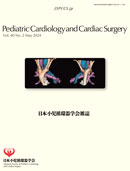Volume 40, Issue 2
Displaying 1-9 of 9 articles from this issue
- |<
- <
- 1
- >
- >|
Preface
-
2024Volume 40Issue 2 Pages 69-70
Published: May 31, 2024
Released on J-STAGE: June 05, 2025
Download PDF (126K)
Review
-
2024Volume 40Issue 2 Pages 71-81
Published: May 31, 2024
Released on J-STAGE: June 05, 2025
Download PDF (439K) -
2024Volume 40Issue 2 Pages 82-90
Published: May 31, 2024
Released on J-STAGE: June 05, 2025
Download PDF (6149K) -
2024Volume 40Issue 2 Pages 91-102
Published: May 31, 2024
Released on J-STAGE: June 05, 2025
Download PDF (5879K) -
2024Volume 40Issue 2 Pages 103-112
Published: May 31, 2024
Released on J-STAGE: June 05, 2025
Download PDF (13644K) -
2024Volume 40Issue 2 Pages 113-120
Published: May 31, 2024
Released on J-STAGE: June 05, 2025
Download PDF (1129K) -
2024Volume 40Issue 2 Pages 121-126
Published: May 31, 2024
Released on J-STAGE: June 05, 2025
Download PDF (556K)
Case Report
-
2024Volume 40Issue 2 Pages 127-131
Published: May 31, 2024
Released on J-STAGE: June 05, 2025
Download PDF (3315K) -
2024Volume 40Issue 2 Pages 132-137
Published: May 31, 2024
Released on J-STAGE: June 05, 2025
Download PDF (2402K)
- |<
- <
- 1
- >
- >|
